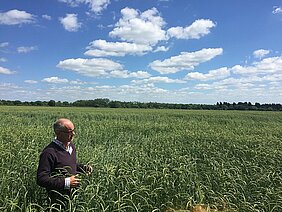Organic principles and standards emphasise the importance of practices that can encourage the long-term health and fertility of agricultural soils, however the actual impact remains uncertain. As part of the OK-Net Arable project, the UK Farm Innovation Group wanted to improve their understanding of the soils beneath their feet. Using a computer-based nutrient budgeting model called NDICEA a researcher from the Organic Research Centre visited seven farms to assess individual field rotations. Together with the researcher they input data from their own farms into the model to identify where nutrient surpluses and deficiencies occur over the seasons and rotation cycle.
In all cases except one, organic matter was found to decline over the course of the rotation, even where leys with a high clover content formed a substantial part of the cropping sequence. An additional discovery was that a lot of the nutrients added to the field through fertilisers (including compost or manure) or grass/clover leys were being lost through leaching or harvest. Meanwhile, breaking the ley in the autumn led to most of the nutrients added being lost before the growing season of the next crop began, due to leaching and denitrification losses over winter.
The model also allowed the farmers to adjust their rotations to see what might happen if they changed their rotation or management practices. They found that;
- The biggest improvements were seen by changing tillage practices.
- Leaving the straw behind has very little effect on nutrient balances
- Breaking the ley in the spring doesn’t improve overall nutrient or organic matter balances.
- Using digestate from anaerobic digestion could present an alternative to rock phosphate
- Increasing the yield of a grass/clover ley can lead to substantial benefits
It must be remembered that no model is 100% accurate and that the outputs given by NDICEA are indications rather than definite outcomes. Overall, the work has revealed some real problems to be addressed within organic arable farming. As farmer John Pawsey (pictured above) said: “No matter which way you look at it we are all mining the soil, unless we are bringing in nutrients to balance exports of meat, straw, forage and grain.”
Further information
Contact
Katie Bliss, Organic Research Centre
Links
- youtube.com: Video "Are we mining our soils?"
- Practice abstract "NDICEA - A digital tool to model nutrient balances across a crop rotation"
